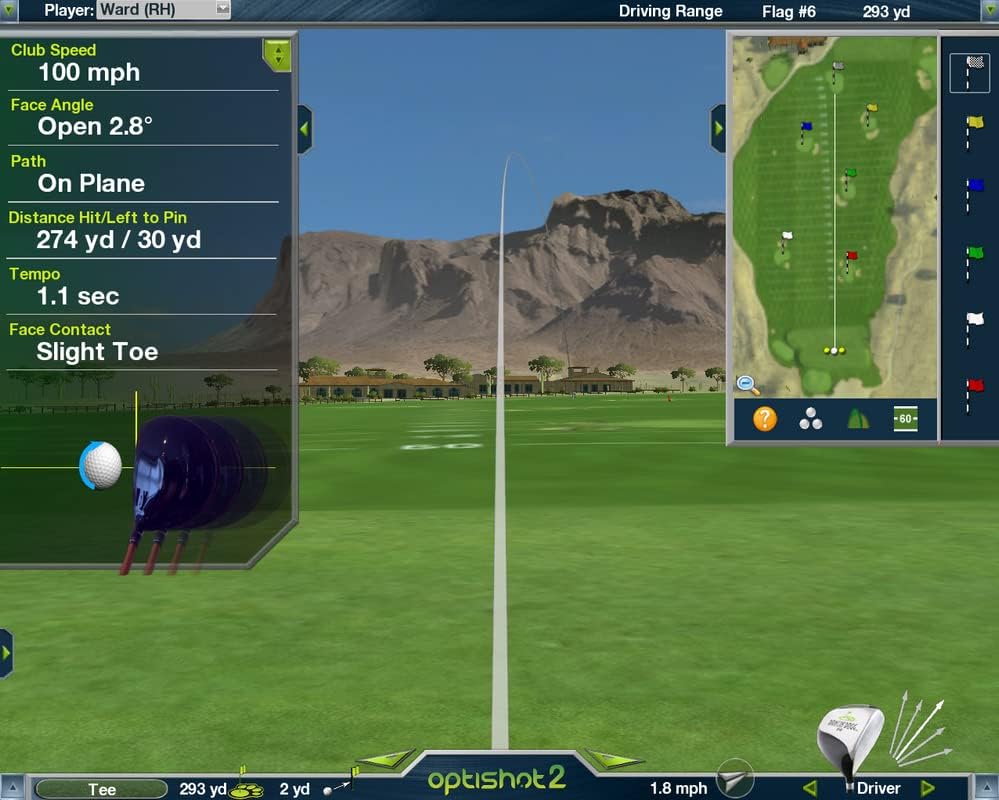how much room do you need for a golf simulator?
I am trying to set up an indoor golf simulator but I am not sure how much space I need for the simulator.
so, how much room do you need for a golf simulator?
When it comes to golf simulators, one of the most important factors to consider is the amount of space required to set one up. Golf simulators can be a great way to practice your swing and improve your game, but if you don’t have enough room, you won’t be able to use one effectively. So, how much room do you need for a golf simulator?
According to several sources, including Nifty Golf, Complete Golf Store, and My Golf Simulator, the minimum room size required for a golf simulator is 12 feet long, 10 feet wide, and 8 feet high.
This will allow you to swing comfortably without any limitations. However, for a more flexible swing, it is recommended to have a room size of 16 feet in length, 12 feet in width, and 9 feet in height. And for the most comfortable swing, 18 feet in length, 15 feet in width, and 10 feet in height is ideal.
It’s important to note that the recommended room size may vary depending on your launch monitor and impact screen setup. Additionally, the width of the room should be at least 15 feet if you want to enjoy a central aim.
When it comes to the height of the room, most golf simulator setups recommend at least a 9-foot ceiling to account for the height of the simulator screen or enclosure, as well as leave some extra space for your golf club when you swing.
Understanding Golf Simulators
Golf simulators are a great way to practice golf indoors. They allow golfers to practice their swing and improve their game without having to go to a golf course. However, before setting up a golf simulator, it is important to understand how much room is needed for it to function properly.
Generally, the minimum room size for a golf simulator is 12 feet in length, 10 feet in width, and 8 feet in height. This is the minimum space required for a golfer to hit a ball and for the simulator to track the ball’s trajectory.
For a more comfortable swing, it is recommended to have a room that is at least 16 feet in length, 12 feet in width, and 9 feet in height. This will allow the golfer to take a full swing without worrying about hitting the ceiling or walls.
It is important to note that the room’s width is just as important as the height. The minimum recommended width for many golf simulators is 12 feet, but if the golfer has a wider backswing, it is recommended to have a room that is at least 15 feet in width. This will allow the golfer to swing the club freely without worrying about hitting anything.
Additionally, it is important to consider the ceiling height when setting up a golf simulator. The minimum recommended ceiling height is 8 feet, but it is recommended to have a ceiling that is at least 9 feet in height. This will allow the golfer to use any club without worrying about hitting the ceiling.
how much room do you need for a golf simulator – Space Requirements for Golf Simulators

Room Size
To set up a golf simulator, a minimum room size of 12 feet in length and 10 feet in width is required. However, it is recommended to have a room depth of 15 feet if the golfer has a wider backswing. The recommended room width is about 15 feet to enjoy a central aim. It is important to avoid a room that is too small or has a low ceiling as it can impact the trajectory of the ball and limit the swing.
Ceiling Height
Ceiling height is another important factor to consider when setting up a golf simulator. The average golfer needs a ceiling height of 9-10 feet to golf indoors comfortably. However, depending on the golfer’s height, arm length, club length, and swing plane, they might be comfortable with a lower ceiling.
It is important to measure the distance from the floor to the highest point of the swing to ensure that the ceiling is high enough for the golfer to swing without any restrictions.
Wall Space
Wall space is also an important consideration when setting up a golf simulator. It is recommended to have a minimum of 10 feet of wall space behind the golfer to allow for the full swing and follow-through. Additionally, it is important to have enough space on the sides of the golfer to accommodate the launch monitor and other equipment.
In conclusion, to set up a golf simulator, a minimum room size of 12 feet in length and 10 feet in width is required, with a recommended room size of 15 feet in width and 15 feet in depth. Ceiling height is also an important factor to consider, with a recommended height of 9-10 feet. Lastly, it is important to have enough wall space to accommodate the full swing and follow-through.
Additional Considerations

Player’s Swing Space
Aside from the minimum room dimensions required for a golf simulator, it is also important to consider the player’s swing space. The player should have enough room to swing comfortably without any restrictions. A wider swing requires more room, so it is recommended to have a room depth of at least 15 feet. This will allow for a full backswing without hitting any objects or walls.
In addition, the room should be free of any obstacles that can interfere with the player’s swing. This includes furniture, equipment, and any other objects that may be in the way. The player should have a clear path to swing without any distractions.
Projector Placement
The placement of the projector is also an important consideration when setting up a golf simulator. The projector should be positioned in a way that provides a clear and unobstructed view of the screen. It should be mounted securely and positioned at the correct distance from the screen to ensure optimal image quality.
The projector should also be placed in a location that is easily accessible for maintenance and adjustments. It should be positioned in a way that allows for easy access to the lens and other components.
Safety Measures
Safety should be a top priority when setting up a golf simulator. The room should be free of any hazards that can cause injury to the player or damage to the equipment. This includes sharp objects, loose equipment, and any other potential hazards.
It is also important to ensure that the equipment is installed correctly and securely. The simulator should be anchored to the floor and the screen should be mounted securely to prevent it from falling or tipping over. The player should also be provided with proper instructions and safety guidelines to ensure a safe and enjoyable experience.
Types of Golf Simulators and Their Space Needs
Portable Golf Simulators
Portable golf simulators are designed for golfers who want to practice their swings and improve their game without having to leave their home. These simulators are compact and easy to set up, making them ideal for small spaces such as apartments or garages.
Most portable golf simulators require a minimum room size of 10 feet by 10 feet by 8.5 feet, but some models may require more space depending on the size of the screen and the length of the golfer’s swing.
In-Ground Golf Simulators
In-ground golf simulators are designed for golfers who want a more permanent solution for their home golf practice. These simulators require more space than portable simulators, but they offer a more immersive experience.
In-ground golf simulators typically require a room size of at least 12 feet by 12 feet by 10 feet, but some models may require more space depending on the size of the screen and the length of the golfer’s swing.
Multi-Sport Golf Simulators
Multi-sport golf simulators are designed for golfers who want to practice other sports in addition to golf. These simulators can be used for sports such as soccer, baseball, and basketball, as well as golf.
Multi-sport golf simulators require more space than portable and in-ground golf simulators, but they offer a wider range of activities. The minimum room size for a multi-sport golf simulator is typically 15 feet by 15 feet by 10 feet, but some models may require more space depending on the size of the screen and the length of the golfer’s swing.
Rounding up, the amount of space required for a golf simulator depends on the type of simulator and the length of the golfer’s swing. Portable golf simulators require the least amount of space, while multi-sport golf simulators require the most.
Kindly note that it is important to measure the available space before purchasing a golf simulator to ensure that it will fit comfortably in the room and provide an enjoyable experience for the golfer.
Optimizing Space for a Golf Simulator
Golf simulators have become increasingly popular among golf enthusiasts who want to practice their swing without leaving their homes. However, to set up a golf simulator, you need to have enough space in your home. In this section, we will discuss how to optimize space for a golf simulator.
Room Layout
The first step in optimizing space for a golf simulator is to determine the room layout. The room should be rectangular in shape and have a minimum length of 12 feet, a minimum width of 10 feet, and a minimum height of 8 feet. However, for a more comfortable swing, it is recommended to have a room that is at least 16 feet long, 12 feet wide, and 9 feet high.
When setting up the golf simulator, it is important to ensure that there is enough clearance between the golfer and the walls. A clearance of at least 2 feet on each side of the golfer is recommended to avoid hitting the walls during the swing. Additionally, the golfer should have enough space to move around freely.
Lighting Conditions
Lighting conditions are also important when setting up a golf simulator. The room should have enough lighting to ensure that the golfer can see the ball and the screen clearly. It is recommended to use bright, white lights to ensure that the screen is visible and the ball is well-lit.
However, it is important to avoid using lights that create glare on the screen. Glare can make it difficult to see the ball and affect the accuracy of the swing. To avoid glare, it is recommended to use lights that are directed away from the screen or to use curtains to block out any glare.
In addition to lighting, it is important to ensure that the room is well-ventilated. Golf simulators can generate a lot of heat, so it is important to have proper ventilation to ensure that the room stays cool and comfortable.
In summary, optimizing space for a golf simulator requires careful planning and consideration of the room layout and lighting conditions. By following these guidelines, golf enthusiasts can set up a comfortable and functional space for practicing their swing at home.
Conclusion
In conclusion, the recommended dimensions for a golf simulator room are at least 12 feet in length, 10 feet in width, and 8 feet in height. However, for a more flexible swing, a room that is 16 feet long, 12 feet wide, and 9 feet high is recommended. And for the most comfortable swing, an ideal dimension is 18 feet in length, 15 feet in width, and 10 feet in height.
It is important to avoid a room that is too small or has a low ceiling as it can impact the trajectory of the ball and limit the swing. The minimum room width for any given simulator setup is around 10 feet. However, the recommended room width is about 15 feet. A room depth of 15 feet is recommended if the golfer has a wider backswing.
Generally speaking, one should strive for a space with 9 feet of ceiling height, 12 feet of width, and 16-18 feet of depth. This should work for most setups. The reality is that the space a golf simulator is housed in is just as important as the quality of the simulator itself.
When building a golf simulator, one should also consider the type of launch monitor and impact screen setup. Depending on the equipment, one may require more length, width, or height. It is important to keep these factors in mind when deciding on the dimensions of the room.
Overall, with the recommended dimensions and proper equipment, a golfer can enjoy a realistic and comfortable golfing experience in the comfort of their own home.






